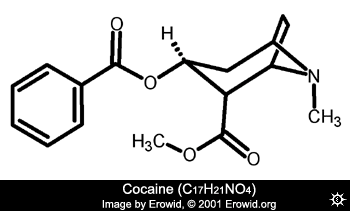INTRODUCTION
Cocaine is an intense, euphoria-producing stimulant drug with strong addictive potential. It's the main alkaloid contained in the leaves of Erythroxylum coca , a plant native to South America, and it is the second most commonly used illicit drug worldwide after cannabis (2013).
MDMA (3,4-methylenedioxy-N-methylamphetamine), also known as ecstasy, is a both stimulant and psychedelic drug that is consumed primarily for its euphoric and empathogenic effects. Even though his name may suggest it, MDMA doesn't contain "amphetamine" but it originate from the safrole , found in plants like the sassafras and the nutmeg(Myristica fragrans ). In 2013 between 9 and 28 million people used ecstasy recreationally primarily for its euphoric and empathogenic effects.


PHARMACODYNAMICS
Both Cocaine and MDMA interact with monoamine transporters and increase extracellular 5-HT, dopamine and noradrenalin activity in the brain. But, while cocaine enhances mostly the dopaminergic system, Serotonin (5-HT) release is the primary pharmacological mechanism of MDMA.
The dopamine (DA) transporter (DAT ) regulates dopaminergic signaling in the central nervous system by maintaining the synaptic concentration of DA at physiological levels, and previous studies suggested that Cocaine and MDMA can modulate its funtion in different ways that both resulting in an increase in extracellular monoamines by decreasing reuptake. Cocaine has been demonstrated to be a non-selective, competitive inhibitor of monoamine transporters, sharing a similar mechanism with that of methylphenidate , that bind as to directly stabilize the DAT transporter on the open outward-facing conformation.

In contrast MDMA enters the presynaptic neuron directly through the neuronal membrane or through monoamine transporters, competing for reuptake with neurotransmitters (most of all, serotonin). Once inside, it binds to TAAR1 or enters synaptic vesicles through VMAT2 (vescicular monoamine transporter 2), again competing with the neurotrasmitter. When MDMA binds to TAAR1 (trace amine-associated receptor 1), it reduces post-synaptic receptor firing rate and triggers protein kinase A and protein kinase C signaling, resulting in transporter phosphorylation. Phosphorylated transporters then either operate in reverse, releasing neurotransmitters from the cytosol to the synaptic cleft, or withdraw into the presynaptic neuron producing a noncompetitive reuptake inhibition of the transporter.

AFFECT ON MIND
The mechanism of action of this two drug shows similarities and differences: cocaine symptoms will be more related to the dopaminergic stimulation, while MDMA symptoms will be more linked to the serotoninergic iper-stimulation.
The intensity of cocaine’s euphoric effects depends on how quickly the drug reaches the brain, which depends on the dose and method of abuse. This results in a rapid-onset, intense euphoric effect known as a “rush" or "high". Other effects include increased alertness and excitation, as well as restlessness, irritability, anxiety and insomnia. Taking high doses of cocaine or prolonged use, such as binging, usually causes paranoia, dysphoria, hallucinations. The crash that follows euphoria is characterized by mental and physical exhaustion, sleep, and depression lasting several days; after that users experience an intese craving to use cocaine again.
MDMA shares many effects with cocaine but it's effects tend to be much longer lasting and it enhances interpersonal and intrapsychic relations, typical of entactogen drugs. The main reason can be found in the serotoninergic system that helps to regulate mood, aggression, sexual activity, sleep, and sensitivity to pain. MDMA causes changes in perception, including euphoria and increased sentitivity to touch, energy, sensual and sexual arousal, need to be touched and empathy and mild hallucinations. Furthermore MDMA is considered the drug of choice during rave and club parties. In those situations the effects of music and lightning can be synergistic with this psychedelic drug.
ADVERSE EFFECTS
Physiological effects of cocaine include increased blood pressure and heart rate, dilated pupils, insomnia, and loss of appetite. The widespread abuse of highly pure street cocaine has led to many severe adverse health consequences such as: cardiac arrhythmias, ischemic heart conditions, sudden cardiac arrest, convulsions, strokes, and death. In some users, the long-term use of inhaled cocaine has led to a unique respiratory syndrome, and chronic snorting of cocaine has led to the erosion of the upper nasal cavity. As many others drug-related disorders, cocaine's advese effects are often associate with psychiatric and paranoid disorders .
Users of MDMA experience many of the same effects and face many of the same risks as users of other stimulants such as cocaine. The most serious short-term physical health risks of MDMA are hyperthermia and dehydration, the other immidiate effects are bruxism, nausea and vomiting, diarrhea, mydriasis. High doses of MDMA can interfere with the ability to regulate body temperature, resulting in a sharp increase in body temperature (hyperthermia), leading to liver, kidney and cardiovascular failure. At nightclubs and rave or techno parties, MDMA is combined with intense physical activity (dancing), crowded conditions (aggregation), high ambient temperature, poor hydration, loud noise, and is commonly taken together with other stimulant club drugs and/or alcohol. This combination is probably the main reason why it is generally seen an increase in toxicity events at rave parties since all these factors are thought to induce or enhance the toxicity (particularly the hyperthermic response) of MDMA.
Studies suggest chronic use of MDMA can produce damage to the serotonin system causing anhedonia. It is ironic that a drug that is taken to increase pleasure may cause damage that reduces person's ability to feel pleasure.
REFERENCES